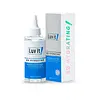What's inside
What's inside
 Key Ingredients
Key Ingredients

 Benefits
Benefits

 Concerns
Concerns

No concerns
 Ingredients Side-by-side
Ingredients Side-by-side

Water
Skin ConditioningChondrus Crispus Extract
Skin ConditioningUrea
BufferingPropylene Glycol
HumectantHyaluronic Acid
HumectantSodium Hyaluronate
HumectantGlycine
BufferingHydrolyzed Sodium Hyaluronate
Skin ConditioningAspartic Acid
MaskingSodium Acetylated Hyaluronate
HumectantPotassium Hyaluronate
Skin ConditioningLysine
Skin ConditioningSodium Hyaluronate Crosspolymer
HumectantValine
MaskingTyrosine
MaskingSerine
MaskingPhenylalanine
MaskingThreonine
Glutamic Acid
HumectantAlanine
MaskingProline
Skin ConditioningLeucine
Skin ConditioningHydrolyzed Hyaluronic Acid
HumectantHydroxypropyltrimonium Hyaluronate
Arginine
MaskingHistidine
HumectantIsoleucine
Skin ConditioningPhenoxyethanol
PreservativeEthylhexylglycerin
Skin ConditioningAllantoin
Skin ConditioningGlucose
HumectantXanthan Gum
EmulsifyingCaprylyl Glycol
EmollientButylene Glycol
Humectant1,2-Hexanediol
Skin ConditioningCitric Acid
BufferingEDTA
Water, Chondrus Crispus Extract, Urea, Propylene Glycol, Hyaluronic Acid, Sodium Hyaluronate, Glycine, Hydrolyzed Sodium Hyaluronate, Aspartic Acid, Sodium Acetylated Hyaluronate, Potassium Hyaluronate, Lysine, Sodium Hyaluronate Crosspolymer, Valine, Tyrosine, Serine, Phenylalanine, Threonine, Glutamic Acid, Alanine, Proline, Leucine, Hydrolyzed Hyaluronic Acid, Hydroxypropyltrimonium Hyaluronate, Arginine, Histidine, Isoleucine, Phenoxyethanol, Ethylhexylglycerin, Allantoin, Glucose, Xanthan Gum, Caprylyl Glycol, Butylene Glycol, 1,2-Hexanediol, Citric Acid, EDTA
 Reviews
Reviews

Ingredients Explained
These ingredients are found in both products.
Ingredients higher up in an ingredient list are typically present in a larger amount.
Allantoin is a soothing ingredient known for its protective and moisturizingg properties. Because of this, it is often added to products with strong active ingredients.
Studies show higher concentrations of this ingredient can promote wound healing.
Though it can be derived from the comfrey plant, allantoin is produced synthetically for cosmetic products to ensure purity.
Learn more about AllantoinButylene Glycol (or BG) is used within cosmetic products for a few different reasons:
Overall, Butylene Glycol is a safe and well-rounded ingredient that works well with other ingredients.
Though this ingredient works well with most skin types, some people with sensitive skin may experience a reaction such as allergic rashes, closed comedones, or itchiness.
Learn more about Butylene GlycolEthylhexylglycerin (we can't pronounce this either) is commonly used as a preservative and skin softener. It is derived from glyceryl.
You might see Ethylhexylglycerin often paired with other preservatives such as phenoxyethanol. Ethylhexylglycerin has been found to increase the effectiveness of these other preservatives.
Phenoxyethanol is a preservative that has germicide, antimicrobial, and aromatic properties. Studies show that phenoxyethanol can prevent microbial growth. By itself, it has a scent that is similar to that of a rose.
It's often used in formulations along with Caprylyl Glycol to preserve the shelf life of products.
Sodium Hyaluronate is hyaluronic acid's salt form. It is commonly derived from the sodium salt of hyaluronic acid.
Like hyaluronic acid, it is great at holding water and acts as a humectant. This makes it a great skin hydrating ingredient.
Sodium Hyaluronate is naturally occurring in our bodies and is mostly found in eye fluid and joints.
These are some other common types of Hyaluronic Acid:
Learn more about Sodium HyaluronateWater. It's the most common cosmetic ingredient of all. You'll usually see it at the top of ingredient lists, meaning that it makes up the largest part of the product.
So why is it so popular? Water most often acts as a solvent - this means that it helps dissolve other ingredients into the formulation.
You'll also recognize water as that liquid we all need to stay alive. If you see this, drink a glass of water. Stay hydrated!
Learn more about Water